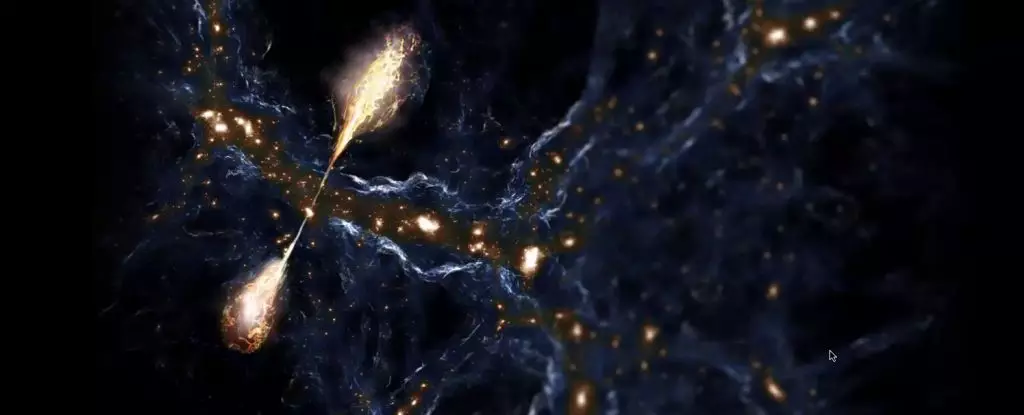Astrophysics continually challenges our understanding of the universe, revealing magnificent structures that defy our imagination. One of the most significant discoveries in recent history is the identification of Porphyrion, a structure formed by a supermassive black hole that has ejected astrophysical jets into the cosmos. Named after the king of giants in Greek mythology, Porphyrion stretches across an astounding 7 megaparsecs, equating to approximately 23 million light-years. This discovery not only showcases the grandeur of the cosmic landscape but also stitches together various threads of astrophysical phenomena, hinting at a more interconnected universe than previously thought.
The empirical evidence surrounding Porphyrion presents an intriguing narrative. It invites scientists and astronomers to rethink prevailing theories about black holes and their influence on cosmic structures. Martijn Oei, an astronomer affiliated with Leiden University and Caltech, encapsulates this sentiment by stating that Porphyrion exemplifies the connection between small and vast entities within the universe. By envisaging the jets as proportions of the Earth and the black hole itself reduced to mere millimeters, we can appreciate the sheer scale of the jets in comparison to their origin, akin to an amoeba producing a fountain of energy surpassing our planet’s size.
One compelling aspect of this discovery is the perspective it offers toward understanding the role of black hole jets. These jets are not simply artifacts of black hole behavior but rather robust agents shaping large-scale cosmic structures. The implications of this scale compel us to parallel it with Alcyoneus, another gigantic structure whose jets span around 16 million light-years. Such findings suggest that the conditions facilitating the creation of these jets might be more ubiquitous in the universe than previously considered, challenging the notion of their rarity.
The genesis of these astrophysical jets is rooted in complex and not entirely comprehended mechanisms. It is established that when supermassive black holes accrete matter, material spiraling inwards gets diverted along magnetic field lines, ultimately erupting as high-speed jets of plasma. This production mechanism invigorates our understanding of cosmic evolution as it converges various astrophysical processes, from gravitational perturbations to electromagnetic interactions.
Nonetheless, the characteristics of the jets from Porphyrion and Alcyoneus present formidable quandaries. For a black hole to constantly generate jets of such expansive scales, it would need a sustained feeding process over time scales measuring billions of years. This continuous feeding suggests the existence of an enormous reservoir of material, a notion that currently challenges conventional models of cosmic evolution. Researchers are left pondering how these black holes acquired the necessary sustenance and maintained stability in their jets over vast distances—a feat not easily synchronized with traditional astrophysical expectations.
Current models theorize that astrophysical jets can exhibit instability over time, leading to their potential disintegration. As Oei points out, suitability for sustainable jet formation hinges on a delicate balance of feeding time and the inherent stability of the jets themselves. The conundrum lies in the extraordinary distance these jets traverse, prompting questions concerning their persistence amidst various forms of cosmic disturbance.
The persistence of Porphyrion’s jets begs further investigative efforts. How could these remarkable structures remain intact across such distances in a universe that is dynamic and ever-evolving? Understanding this phenomenon could provide crucial insights into the broader framework of the cosmic web—a colossal network composed of dark matter filaments, galaxy cluster hubs, and expansive voids. Scientists propose that the jets may significantly influence cosmic temperature variations and magnetic field formations within those voids, hinting at a deeper relationship between jet dynamics and cosmic structure.
This newfound understanding of giant jets opens the door to exciting possibilities. Oei speculates that the prevalence of galaxies with similar dramatic jet systems might surpass current calculations. As observational instruments improve and expand our cosmic horizons, it is highly likely that we will uncover a plethora of such galaxies, thereby enriching our comprehension of cosmic evolution.
As experimental methodologies and observational technologies evolve, the field of astrophysics is poised for a renaissance. The exploration and understanding of structures like Porphyrion could be pivotal in unraveling other mysteries of the universe, shifting paradigms in our comprehension of galactic formation and transformation. With each discovery, we inch closer to answering the most profound questions about the cosmos, further elucidating the intricate tapestry that binds the universe together.


Leave a Reply